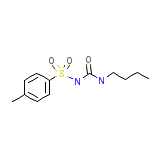Orinase Diagnostic




Categoria
Orinase Diagnostic Nombres de marca, Orinase Diagnostic Analogos
- Aglicid
- Apo-Tolbutamide
- Arkozal
- Artosin
- Artozin
- Butamid
- Butamide
- Diaben
- Diabetamid
- Diabetol
- Diabuton
- Diasulfon
- Dirastan
- Dolipol
- Drabet
- Glyconon
- Ipoglicone
- Mobenol
- Novo-Butamide
- Orabet
- Oralin
- Orezan
- Orinase
- Orinase Diagnostic
- Orinaz
- Oterben
- Pramidex
- Rastinon
- Restinon
- Sk-tolbutamide
- Tol-Tab
- Tolbusal
- Tolbutamid
- Toluina
- Tolumid
- Toluvan
- Tolylsulfonylbutylurea
- Willbutamide
Orinase Diagnostic Marca los nombres de mezcla
Orinase Diagnostic Formula quimica
C12H18N2O3S
Orinase Diagnostic RX enlace
No information avaliable
Orinase Diagnostic FDA hoja
Orinase Diagnostic MSDS (hoja de seguridad de materiales)
Orinase Diagnostic Sintesis de referencia
No hay información disponible
Orinase Diagnostic Peso molecular
270.349 g/mol
Orinase Diagnostic Punto de fusion
128.5 oC
Orinase Diagnostic H2O Solubilidad
109 mg / L
Orinase Diagnostic Estado
Solid
Orinase Diagnostic LogP
2.765
Orinase Diagnostic Formas de dosificacion
Tablet (250 y 500 mg)
Orinase Diagnostic Indicacion
Se usa como un agente hipoglucemiante oral en no insulino-dependiente Mileto Diabetes (tipo 2) con la edad adulta.
Orinase Diagnostic Farmacologia
Tolbutamida, una sulfonilurea de segunda generación contra la diabetes, se utiliza con una dieta para reducir los niveles de glucosa en sangre en pacientes con diabetes mellitus tipo II. Tolbutamida es dos veces tan potente como el relacionado con la segunda generación de agentes de glipizida. Tolbutamida disminuye el azúcar en la sangre al estimular el páncreas para secretar insulina y ayudando al cuerpo a utilizar la insulina eficientemente. El páncreas debe ser capaz de producir insulina para que este medicamento funcione.
Orinase Diagnostic Absorcion
Se absorbe bien. La absorción no se altera si se toma con alimentos, pero se incrementa con un pH alto.
Orinase Diagnostic Toxicidad
Ratón por vía oral, LD50 = 2600 mg / kg
Orinase Diagnostic Informacion de Pacientes
Treatment with tolbutamide may increase the risk of death from cardiovascular disease compared to treatment of diabetes with diet alone or diet plus insulin. Discuss with your doctor the risks and benefits of treatment with tolbutamide. Know the signs and symptoms of low blood sugar (hypoglycemia), which include headache, drowsiness, weakness, dizziness, fast heartbeat, sweating, tremor, and nausea. Carry a piece of hard candy or glucose tablets with you to treat episodes of low blood sugar. Follow your diet, medication, and exercise routines closely. Changing any of them can affect blood sugar levels. Do not change your dose of tolbutamide without first talking to your doctor. Avoid alcohol. It lowers blood sugar and may interfere with your diabetes treatment.
Orinase Diagnostic Organismos afectados
Humanos y otros mamíferos














